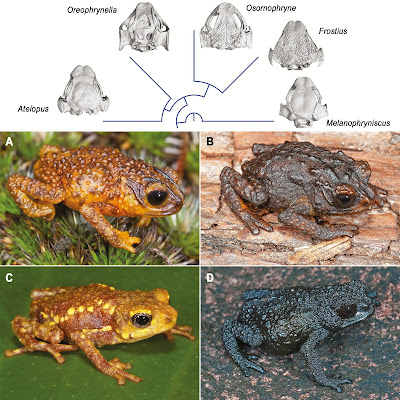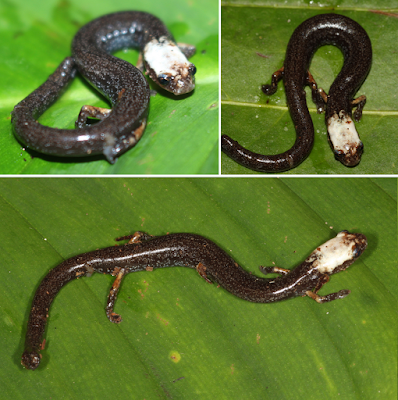[Most Recent Entries] [Calendar View]
Saturday, October 3rd, 2020
| Time | Event | ||
| 7:06a | [Herpetology • 2020] Coping with the Extremes: Comparative Osteology of the Tepui-associated Toad Oreophrynella and Its Bearing on the Evolution of Osteological Novelties in the Genus Abstract The only study of the osteology of the toad genus Oreophrynella dates back to 1971 and was based on a single species. Here, we use high-resolution X-ray microcomputed tomography to analyse the osteology of all nine described Oreophrynella species, which are compared with representatives of other bufonid lineages. Oreophrynella is unique among bufonids in having opposable digits. Osteological synapomorphies confirmed for the genus are as follows: presence of parietal fontanelles and exposed frontoparietal fontanelle, absence of quadratojugal, five presacral vertebrae, distally enlarged terminal phalanges and urostyle greatly expanded into flanges. Ancestral character reconstruction indicates that arboreal habits in some Oreophrynella species are likely to have evolved after the evolution of opposable digits. Opposable digits, in combination with an extension of the interdigital integument and the relative length/orientation of the digits, are likely to be adaptations to facilitate life on rocky tepui summits and an exaptation to arboreality. Cranial simplification in Oreophrynella, in the form of cranial fontanelles and absence of the quadratojugal, is possibly driven by a reduction of developmental costs, increase in flexibility and reduction of body weight. Cranial simplification combined with the shortening of the vertebral column and the shift towards a partly firmisternal girdle might be adaptations to the peculiar tumbling behaviour displayed by Oreophrynella. Keywords: Amphibia, ancestral reconstruction, Guianas, heterodactyly, high-resolution X-ray microcomputed tomography, Pantepui Philippe J. R. Kok, Milan A. J. van der Velden, D. Bruce Means, Sebastian Ratz, Iván Josipovic, Matthieu Boone and Roy W. McDiarmid. 2020. Coping with the Extremes: Comparative Osteology of the Tepui-associated Toad Oreophrynella and Its Bearing on the Evolution of Osteological Novelties in the Genus. Zoological Journal of the Linnean Society. 190(1); 114–139. DOI: 10.1093/zoolinnean/zlz172 | ||
| 7:07a | [Herpetology • 2020] Coping with the Extremes: Comparative Osteology of the Tepui-associated Toad Oreophrynella and Its Bearing on the Evolution of Osteological Novelties in the Genus Abstract The only study of the osteology of the toad genus Oreophrynella dates back to 1971 and was based on a single species. Here, we use high-resolution X-ray microcomputed tomography to analyse the osteology of all nine described Oreophrynella species, which are compared with representatives of other bufonid lineages. Oreophrynella is unique among bufonids in having opposable digits. Osteological synapomorphies confirmed for the genus are as follows: presence of parietal fontanelles and exposed frontoparietal fontanelle, absence of quadratojugal, five presacral vertebrae, distally enlarged terminal phalanges and urostyle greatly expanded into flanges. Ancestral character reconstruction indicates that arboreal habits in some Oreophrynella species are likely to have evolved after the evolution of opposable digits. Opposable digits, in combination with an extension of the interdigital integument and the relative length/orientation of the digits, are likely to be adaptations to facilitate life on rocky tepui summits and an exaptation to arboreality. Cranial simplification in Oreophrynella, in the form of cranial fontanelles and absence of the quadratojugal, is possibly driven by a reduction of developmental costs, increase in flexibility and reduction of body weight. Cranial simplification combined with the shortening of the vertebral column and the shift towards a partly firmisternal girdle might be adaptations to the peculiar tumbling behaviour displayed by Oreophrynella. Keywords: Amphibia, ancestral reconstruction, Guianas, heterodactyly, high-resolution X-ray microcomputed tomography, Pantepui Philippe J. R. Kok, Milan A. J. van der Velden, D. Bruce Means, Sebastian Ratz, Iván Josipovic, Matthieu Boone and Roy W. McDiarmid. 2020. Coping with the Extremes: Comparative Osteology of the Tepui-associated Toad Oreophrynella and Its Bearing on the Evolution of Osteological Novelties in the Genus. Zoological Journal of the Linnean Society. 190(1); 114–139. DOI: 10.1093/zoolinnean/zlz172 | ||
| 7:43a | [Herpetology • 2020] Oedipina ecuatoriana & O. villamizariorum • Two Extremely Rare New Species of Fossorial Salamanders of the Genus Oedipina (Caudata: Plethodontidae) from northwestern Ecuador
Abstract We describe two new species of salamanders of the genus Oedipina, subgenus Oedopinola, from two localities on the northwestern foothills of Ecuador, at elevations between 921 and 1,067 m. These are the southernmost members of the genus. We examined different museum collections and we found just three specimens of Oedipina from Ecuador, obtained throughout the history of herpetological collections in the country. We identify two of the three specimens as new species, but refrain from assigning a specific identity to the third, pending further study. Oedipina villamizariorum sp. n. is a medium-sized member of the genus, with a narrow, relatively pointed head and blunt snout; dorsolaterally oriented eyes, moderate in size; and digits that are moderately long and having pointed tips. Oedipina ecuatoriana sp. n., somewhat larger, has a narrow head and broadly rounded snout; this new species differs from all known Oedipina by the distinctive presence of paired prefrontal bones and a reduced phalangeal formula: 0-0-1-0; 0-1-2-1-1. We provide detailed descriptions of the osteology of both new species. Finally, we present a phylogenetic hypothesis for the genus, including one of the two new species, based on partial sequences of mitochondrial DNA. Oedipina villamizariorum sp. n. Proposed standard English name: Villamizar’s worm salamander Proposed standard Spanish name: Salamandra gusano de Villamizar Diagnosis. We assign Oedipina villamizariorum to the genus Oedipina (Keferstein, 1868) based on the characterization of Brame (1968): 18 trunk vertebrae (18–23 in the genus, versus 14 in all other Bolitoglossini); 17 costal grooves per side; sublingual fold present; body greatly attenuated; limbs very short (8.5 costal folds exposed when limbs appressed to sides of trunk); very long tail, up to more than twice standard length (the tail is broken but based on the size of remaining vertebrae apparently was very long when complete). In addition, we assign the new species to the subgenus Oedopinola (Hilton, 1946) (equivalent to the parvipes group of Brame, 1968) based on the characterization of Brame (1968) and García-París & Wake (2000) of having 18 trunk vertebrae and often possessing a white face mask (i.e., dorsal coloration on the head). ... Distribution and natural history. Oedipina villamizariorum inhabits Evergreen lowland forests of the Ecuadorian Chocó (sensu MAE 2013). The new species is known only from one specimen collected at the type locality on the western foothills (920 m) of the Andes in the province of Carchi, Ecuador. The holotype was collected during excavations along stony edges of a stream with bushy thick canopy, near forest clearings, between 10:00 and 12:00 in the morning. The specimen was found at approximately 15 cm depth inside moist humus-rich soil covered with moderate leaf litter. One individual of caecilian was found a few meters away. Etymology. Named in honor of Jorge and María Teresa Villamizar of Cumbayá, Ecuador; parents of Felipe Villamizar, who has been an important supporter of forest conservation in the area where this species was discovered. The noun is the genitive plural of the last name of the family. Oedipina ecuatoriana sp. n. Proposed standard English name: Ecuadorian worm salamander Proposed standard Spanish name: Salamandra gusano ecuatoriana Diagnosis. We assign Oedipina ecuatoriana to the genus Oedipina following the characterization of Brame (1968) based on the following combination of characters: 18 trunk vertebrae; 17 costal grooves per side; sublingual fold present; body greatly attenuated; limbs small (9 costal folds exposed when limbs appressed to sides of trunk); very long tail, more than twice standard length. In addition, we assign the new species to the subgenus Oedopinola (García-París & Wake, 2000) on the basis of having 18 trunk vertebrae. ... Distribution and natural history. Oedipina ecuatoriana presumably inhabits Evergreen lowland mountain forests of Ecuadorian Chocó (sensu MAE, 2013). The holotype was obtained by professional collectors at “Paramba”, which we assume is near the present-day Hacienda Paramba, in the western foothills of the province of Imbabura. This is the southernmost locality of the genus Oedipina. The species is known only from the holotype and no further details are available (See Remarks). Etymology. The name “ecuatoriana” honors the country of Ecuador, an important center of amphibian biodiversity. Conclusions: We provide morphological, osteological and genetic evidence (for Oedipina villamizariorum) that validates the description of two new species of extremely rare salamanders, O. villamizariorum sp. n. and O. ecuatoriana sp. n. We found three specimens of Oedipina within Ecuadorian territory in museum collections, two of which we describe as new species, but we refrain from assigning the third, since further study is pending. Oedipina ecuatoriana is the first species of Oedipina with the presence of paired prefrontal bones and a greatly reduced phalangeal formula: 0-0-1-0; 0-1-2-1-1. Finally, we present a phylogenetic hypothesis for the genus, including one of the two new species. Carolina Reyes-Puig, David B. Wake, Ramachandran Kotharambath, Jeffrey W. Streicher, Claudia Koch, Diego F. Cisneros-Heredia, Mario H. Yánez-Muñoz and Santiago Ron. 2020. Two Extremely Rare New Species of Fossorial Salamanders of the Genus Oedipina (Plethodontidae) from northwestern Ecuador. PeerJ. 8:e9934. DOI: 10.7717/peerj.9934 |
| << Previous Day |
2020/10/03 [Calendar] |
Next Day >> |





